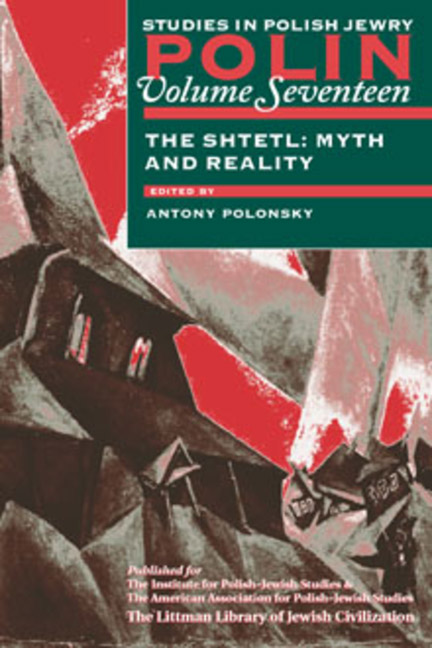Book contents
- Frontmatter
- Dedication
- Editors and Advisers
- Preface
- Polin
- Polin: Studies inPolish Jewry
- Contents
- Note on Place Names
- Note on Transliteration
- List of Abbreviations
- PART I THE SHTETL: MYTH AND REALITY
- Introduction. The Shtetl: Myth and Reality
- The Shtetl as an Arena for Polish–Jewish Integration in the Eighteenth Century
- Inter-Religious Contacts in the Shtetl: Proposals for Future Research
- The Hasidic Conquest of Small-Town Central Poland, 1754–1818
- The Drama of Berdichev: Levi Yitshak and his Town
- Polish Shtetls under Russian Rule, 1772–1914
- How Jewish Was the Shtetl?
- The Changing Shtetl in the Kingdom of Poland during the First World War
- The Shtetl: Cultural Evolution in Small Jewish Towns
- Small Towns in Inter-War Poland
- Jewish Patrons and Polish Clients: Patronage in a Small Galician Town
- Maintaining Borders, Crossing Borders: Social Relationships in the Shtetl
- The Soviet Shtetl in the 1920s
- Shtetl and Shtot in Yiddish Haskalah Drama
- Kazimierz on the Vistula: Polish Literary Portrayals of the Shtetl
- Imagining the Image: Interpretations of the Shtetl in Yiddish Literary Criticism
- Shtetl Codes: Fantasy in the Fiction of Asch, Schulz, and I. B. Singer
- Returning to the Shtetl: Differing Perceptions
- PART II NEW VIEWS
- PART III DOCUMENTS
- PART IV THE SIXTY-FIFTH ANNIVERSARY OF EVENTS IN PRZYTYK: A DEBATE
- PART V REVIEWS
- OBITUARIES
- Notes on the Contributors
- Glossary
- Index
The Shtetl as an Arena for Polish–Jewish Integration in the Eighteenth Century
from PART I - THE SHTETL: MYTH AND REALITY
- Frontmatter
- Dedication
- Editors and Advisers
- Preface
- Polin
- Polin: Studies inPolish Jewry
- Contents
- Note on Place Names
- Note on Transliteration
- List of Abbreviations
- PART I THE SHTETL: MYTH AND REALITY
- Introduction. The Shtetl: Myth and Reality
- The Shtetl as an Arena for Polish–Jewish Integration in the Eighteenth Century
- Inter-Religious Contacts in the Shtetl: Proposals for Future Research
- The Hasidic Conquest of Small-Town Central Poland, 1754–1818
- The Drama of Berdichev: Levi Yitshak and his Town
- Polish Shtetls under Russian Rule, 1772–1914
- How Jewish Was the Shtetl?
- The Changing Shtetl in the Kingdom of Poland during the First World War
- The Shtetl: Cultural Evolution in Small Jewish Towns
- Small Towns in Inter-War Poland
- Jewish Patrons and Polish Clients: Patronage in a Small Galician Town
- Maintaining Borders, Crossing Borders: Social Relationships in the Shtetl
- The Soviet Shtetl in the 1920s
- Shtetl and Shtot in Yiddish Haskalah Drama
- Kazimierz on the Vistula: Polish Literary Portrayals of the Shtetl
- Imagining the Image: Interpretations of the Shtetl in Yiddish Literary Criticism
- Shtetl Codes: Fantasy in the Fiction of Asch, Schulz, and I. B. Singer
- Returning to the Shtetl: Differing Perceptions
- PART II NEW VIEWS
- PART III DOCUMENTS
- PART IV THE SIXTY-FIFTH ANNIVERSARY OF EVENTS IN PRZYTYK: A DEBATE
- PART V REVIEWS
- OBITUARIES
- Notes on the Contributors
- Glossary
- Index
Summary
As with much of Jewish history, one of the major problems involved in the historical study of the shtetl is distinguishing between myth and reality—in this case, between the picture obtained from the critical analysis of the historical sources and the image of historical phenomena developed by generations of Jews. As modern research has shown, the shtetl has enjoyed a prominent place in Jewish popular consciousness, which perceives it as a quintessentially Jewish place where Yiddish was the dominant language, life was lived to Jewish rhythms, and the outside, non- Jewish world impinged only rarely (and then often negatively, to persecute the Jews). This image of the small Jewish town has been bolstered in modern sociological and historical texts, which have uncritically transmitted this popular perception to their readers and thus perpetuated the Jewish collective memory.
In addition, the fact that Jewish historical research itself has played a key role in the modernization of the Jewish people means that the authors of the historical studies have also had an ideological stake in the way that various phenomena in Jewish history have been portrayed. Since modernization is widely perceived as involving the processes of urbanization, economic development, and Jewish integration into the surrounding society, scholars (as well as publicists and others) have had a vested interest in contrasting modern Jewish life—viewed as positive—with a negative past which was neither urban nor integrated into surrounding society. In many respects, the shtetl in eastern Europe was an ideal counterpoint to the values of modernity; its image as a social and cultural backwater with a failing economy and as a place where social conservatism prevented significant connections between the Jewish and non-Jewish worlds has thus gained great currency and may be found in Jewish historical writing to this day.
Scholarly research cannot therefore afford to ignore the development of the images of the shtetl as social and historical constructs that shed light on the cultural development of the societies that gave rise to them. However, this means that it is no longer possible to accept these popular historical images at face value as representations of historical reality, since that would entail accepting the cultural preconceptions on which they were based.
- Type
- Chapter
- Information
- The Shtetl: Myth and Reality , pp. 25 - 40Publisher: Liverpool University PressPrint publication year: 2004



